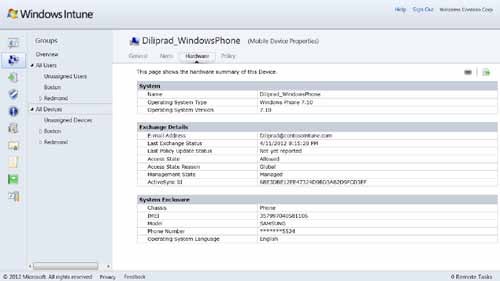当微软Intune的第一几年前就出来了每月超过15 $ /用户,有效地只做从云系统打补丁,我想知道谁到底会支付那么多钱的东西你可以免费(只需使用Windows办从云端更新)。但是,这是Intune的1.0版本,或者是微软官方称为波“A”的产品。
我们在这里,2年后和波“C”(即:产品的V3.0),我不得不说,我们有我们的客户很多移动Intune中的过程。为什么?以下是Intune的为$ 11美元包月费现在提供/用户/月(零售(便宜,如果你有超过250个用户,已经有软件保障等)的企业协议:
- 升级Windows 7企业版的权利:那么对于所有的Windows计算机上,你可以把它们无需购买单独的Windows许可证升级到Windows 7(和Windows 8)。It’s effectively Software Assurance for Windows AND it’s the “Enterprise” edition of Windows, which for small businesses, you typically can’t buy the Enterprise edition (unless you buy an Enterprise Agreement that has a breakeven for orgs typically with more than 220 users). Windows Enterprise gives you things like DirectAccess, BranchCache, Bitlocker, AppLocker, rights to run Windows in a VDI environment, and multi-lingual user support
- 集中式管理控制台:Intune中有一个集中的(基于网络的)管理控制台,管理员可以看到Intune的管理台式机,笔记本电脑和手机一眼,见补丁/更新状态,在硬件/软件清单挖掘,应用策略等等。

- 硬件和软件清单:您的终端将被扫描和所有的硬件/软件清单将被更新到集中Intune的管理控制台,让你可以安装的软件,并在计算机上使用一个准确的库存,以及可以做硬件验证,以确认系统是否能够运行Windows 7或8,或磁盘空间用完,或类似的。注:空间是Windows客户端和移动电话完成的,所以你可以做移动设备管理与Intune的

- 手机管理:在手机管理的主题,为手机Intune的意志库存和控制政策,包括Windows Phone 7和以后,苹果iOS 4.x版/ 5.x和更高版本(即:iPad和iPhone)和Android V21.1和更高版本。与Intune的手机管理集成与ActiveSync,所以手机需要同步的东西,如Microsoft Exchange,其中Intune的政策和管理是通过同步与Exchange执行。

- 软件补丁/更新:Intune的补丁和更新的Windows客户端系统被“接合”未加入到Active Directory中的Microsoft Active Directory域和系统的系统。这是一个很大的事情上,前提很多产品都需要托管的Windows系统是AD加盟,Intune中提供的只是独立系统相同的能力。

- Software Catalog / Software Distribution: Intune provides a “software catalog” where an organization can upload packages that user’s can then download and install on their computers, things like Visio, Office, Lync client, Java apps, Adobe Acrobat, Autocad, etc. For Windows-based systems, software in the Software Catalog can be tagged to be Pushed to Intune managed Windows endpoints automatically. This can allow the organization the ability to do either direct Software Distribution or allow users to more benignly logon to an “App Catalog” and pick/choose applications and download/install them on their own. The organization can create its own packages and put them in their own Intune online catalog so that specific features can be installed on user systems based on how the organization wants the app installed.

- 反恶意软件:Intune的还包括反恶意软件(反病毒/反垃圾邮件)端点防护软件许可的一部分,这样可以保证端点保护,并充分利用Intune中的补丁/更新能力,以保持签名文件对于反恶意软件处于最新状态。微软采用了相同的技术,因为他们在System Center 2012端点保护提供,因此,一个企业级的反恶意软件解决方案

- 远程控制:Intune中为管理员提供了远程控制Windows端点提供技术支援服务的用户,无论他们在哪里的能力,以及端点系统再次,无论是结构域附着与否。Intune的可用于简单的远程控制支持对任何托管端点系统,因为遥控器支持域连接和非域连接Windows端点的灵活性的最佳解决方案之一。
- Active Directory Federation: This is a slick function built in to Intune, effectively the ability to sync the organization’s Active Directory with Intune so that policies, management, etc are done in association with “user accounts” in Active Directory as it relates to managed Intune endpoints. So when Intune identifies an iPhone and a Windows tablet under Intune management, those devices are associated with an authorized AD user. This makes user / device association, identification, and ultimately device policy management easier as policies can be applied by AD user…

- 策略/设置管理:Intune的为企业提供端点系统,类似于当系统连接到企业网络的“组策略”的能力,推动策略和设置,但由于这些端点不一定加入域和连接到企业网络这些政策/设置可以被应用到“任何” Intune的管理端点,连接或不域。

- 主动报警:Intune的必须提供系统的“健康”信息反馈给Intune的控制台预先定义的监视任务的能力,是影响管理端点的整体“健康”。该Intune管理员可以查看和用户在遇到问题时打电话之前的系统多次运行状况报告。

- 许可协议管理:Intune的具有组织进口(或手动密钥)许可证(微软和非微软),该组织已购买的能力,然后在清单编制过程中有什么Intune的认定比较许可证授权。这有助于企业了解许可任何差距,并能主动管理许可证(即:对不需要的软件的系统中删除软件)继续遵守与软件的权利。

那么,在Intune中是不是有些单位部门可能希望/需要:
- 苹果Mac管理:目前,Intune中没有为苹果电脑不管是打补丁,软件分发,远程控制,或反恶意软件提供任何端点管理。这是后话微软无疑将在即将推出的版本是与系统中心2012 SP1上的前提下,微软包括MAC管理代理以及端点保护(反恶意软件)的Mac电脑,所以这一点是提供支持无疑将是即将到来的
- 在移动设备上的无线下载更新:Intune的目前不推“空中”到移动设备的更新,所以尽管有在空中做更新的能力,就像苹果iOS V5.x的东西和6.x版的设备,Intune的不能强迫现在更新。组织可以生成报告,以确定手机可能会运行OS像iOS的6.0“坏”的版本,应该更新到更新版本以修复6.0 ActiveSync的错误,然后使IT部门能够通知用户更新他们的设备,所以这可以通过通知完成,只是没有主动现在强迫。
- 操作系统部署:Intune中不会推出一个操作系统到端点,像做了的Windows XP到Windows 7的升级。大多数OS图像是2GB,5GB,10GB的大小,所以试图从云中推送一个完整的操作系统可以吸取了大量的带宽,因此,操作系统部署当前预置只。
- Integration with System Center 2012 On-Premise: Currently Intune is standalone, managed from a Cloud-based admin console and does not tie into an organization’s on-premise Sysetm Center 2012 Configuration Manager console, however in the next major release of Intune from Microsoft (called Wave “D”), it has been stated that Microsoft will provide SCCM/2012 integration and management with Intune.
- 服务器管理:目前Intune的聚焦在管理客户端点如台式机,笔记本电脑和手机,它不会在数据中心管理服务器。对于数据中心的服务器管理,微软的解决方案是系统中心2012配置管理器上的前提。微软没有提到在未来与Intune的支持服务器还没有,现在和可预见的未来,似乎内部部署Ssytem中心2012解决方案仍然是最好的服务器管理
- 企业服务台:Intune中有一个“轻”中央管理控制台,它提供的观点软件清单,硬件清单,补丁和更新的状态,等等,但它不是一个完全成熟的服务支持体系。用户可以提交支持的请求,并且管理员可以使用Intune的管理控制台进行远程控制端点系统,但是如果你正在寻找在那里支持票可以进入,事件可以委托,提供支援信息的提供完整的服务支持体系,记录和报告公开船票,目前微软只提供了系统中心2012服务管理内部部署的解决方案。The use of SC/2012 Service Manager is in line with Microsoft’s focus of providing datacenter support with the on-premise System Center 2012 product that also includes server management, server patching/updating, virtual machine management, and enterprise datacenter monitoring, all components of SC/2012.
那么,这是否适合Intune的吗?它肯定适合于小十岁上下的组织(下500个用户)有主要基于Windows的系统以及混合各种手机和平板电脑(即:WINDOWS,苹果,安卓),其中组织希望端点管理,远程control support for PCs, anti-malware, inventory, policy management, etc and doesn’t want to setup servers inhouse. This fits very well with organizations moving to Office 365 in the cloud, as the organization leverages Exchange / Lync / SharePoint in the cloud and gets rid of internal servers for those resources, following suit with Intune for endpoint management tends to be the next step where it makes sense.Intune fits mid and large size organizations in strategic areas, as an example, we had a client that had thousands of users, had a full System Center 2012 on-premise implementation to support servers and client systems that it intends to keep, but had a remote office that was not easy to fit into the traditional endpoint management of System Center (ie: systems are not joined to the domain, systems were mostly mobile users, lots of systems are BYOD user owned, organization needed to ensure it could monitor and track anti-malware and enforce certain policies, but in a lighter manner than traditional domain-attached systems). Intune fit this environment perfectly as it addressed the management needs without the big brother footprint.Another environment where Intune fit perfectly was an organization that had kiosks and remote systems that were internet connected, but not domain attached (thousands of these systems worldwide). By installing Intune on the systems, the organization was able to apply policies, identify the systems, control the systems, but it required far less overhead than putting on VPN clients, implementing WAN connections, domain attachment of the endpoints, or the like.Can’t say that Intune is perfect for everyone right now if the org has a lot of Macs or looking for an OS Deployment solution or server management solution, of which the organization can look at System Center 2012 on-premise or wait for an upcoming update from Microsoft to Wave “D” of Intune (which the waves seem to cover every 6-9 months, this latest Wave “C” came out June/2012). As with any service in the cloud, the major releases come pretty frequently and if it has been more than a year since you tried something or checked up on something, you need to re-review the solution as the cloud solution may likely have the full support you are looking for now.Hope this helps, a bit of an inside view of Intune in the cloud!Several other postings I’ve done on Windows Server 2012 and Exchange 2013, just click the Next Article or Previous Article buttons on this blog post to get to other articles I’ve covered, or//m.banksfrench.com/community/morimoto看到所有的各种博客文章,我多年来所付出的列表。希望这个信息是有帮助的!

http://www.cco.com)微软与微软技术的产品2 - 3年之前的作品的早期采用者的合作伙伴发布给公众。兰德的书的作者“Windows Server 2012中如虎添翼”,在技巧,窍门,最佳实践和经验教训通过萨姆斯出版在Windows 2012中了解到1565页;“交易所2013如虎添翼”,第一本书在世界上的Exchange 2013基础上在一年中的交易的最新版本的早期采用者的生产实施,以及“系统中心2012如虎添翼”,在春季发布了1000多页的书2012基于在2-1 / 2年2012系统中心的早期采用者部署。
兰德森本是收敛计算的总统(





